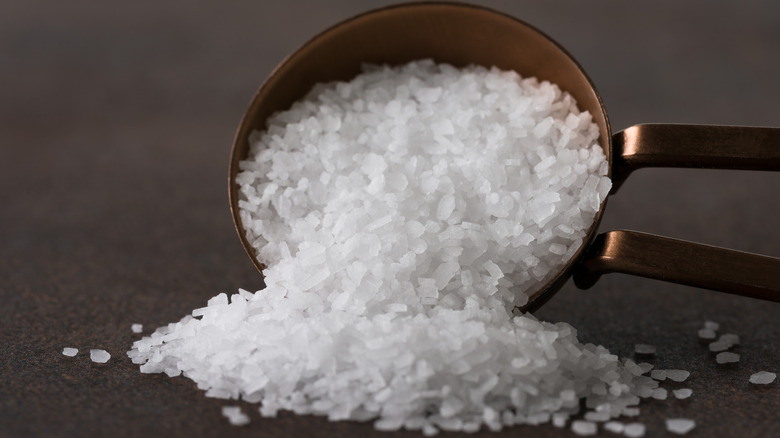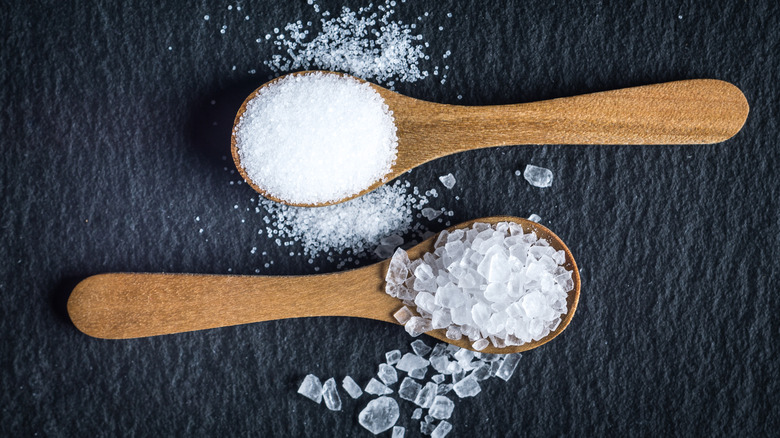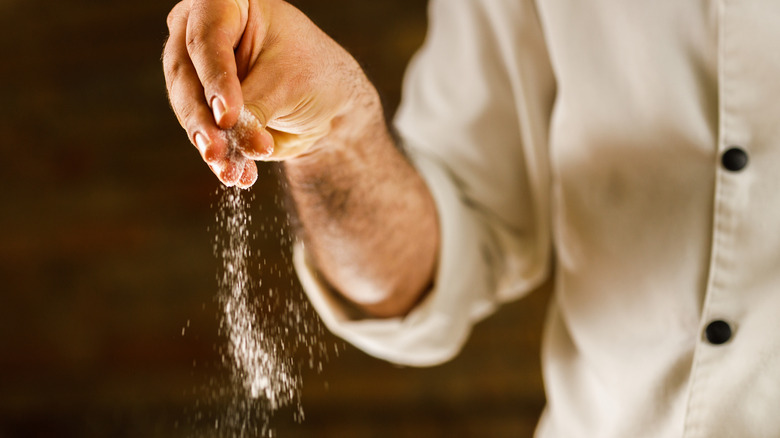What Exactly Makes Kosher Salt Different From The Rest?
When it comes to seasoning in recipes, you probably regularly see "table salt," "sea salt," or just regular "salt" on the ingredients list. What about "kosher salt"? Kosher salt appears on many cooking websites, from the recipe sections of newspapers to beloved food blogs. It has been around for a long time (more on that in a moment), but only in the past few decades have we seen its increased use in non-Jewish home kitchens, trickling down from its favored use in restaurant kitchens — so much so that kosher salt can be said to be the only salt you need.
Kosher salt is different from other types of salt due to several key characteristics. First of all, its medium grain means that it is a good midway size between coarse rock salt and fine table salt, making it easy to pick up with your fingers. It is also made from pure sodium chloride, different than many naturally occurring salts that include other minerals. The sodium-chloride makeup adds a clean saline flavor to the food being cooked. Both points are important for food preservation reasons, as kosher salt will not add unexpected colors or flavors to what is being pickled or cured, and it's easily washed away after it has done its job.
A look under the microscope
The origins of kosher salt go back centuries, as the intended use of this particular salt was to draw out blood (or myoglobin, as we now know) from red meat, as blood is prohibited for Jewish consumption. The size of the salt grains made it easy to wash off once the koshering process was complete, and the meat could then be cooked for the family.
You read that right — "kosher salt" is actually a misnomer for "koshering salt," also known as salt that is used for the koshering process. The salt processing companies Diamond and Morton labeled koshering salt as "kosher salt" in the 1920s to market to the Jewish community, and the name stuck.
Restaurant chefs began to favor kosher salt because it was dry and easy to pinch between one's fingers and sprinkle into cooking food. Regular table salt was not ideal for this application because of the addition of iodine and anti-caking ingredients. Natural salts like sea salts didn't work, either, because their high moisture levels made the grains stick to fingers much more easily. Kosher salt it was, and as have many other chef-y tricks, it eventually made its way to home kitchens.
Get the most out of your kosher salt
Whether you are in the Diamond Crystal camp or Morton camp, what is important that is you know that the two brands are not interchangeable. The crystals of Diamond Crystal kosher salt are more brittle compared to the denser Morton kosher salt, making the latter noticeably saltier by volume. And, if you know that the two brands of kosher salt cannot be substituted for each other, you would also know that it is especially true that two types of salt cannot be substituted for each other. As noted above, different types (and brands) of salt have different sizes, shapes, and mineral content. A recommended way to substitute one salt for the other is by weight instead of volume, but even then the shape of its grains will affect how it dissolves into the food. Your best bet is to add a little bit of salt at a time and use the tool you were born with — your tongue. Just be sure to also avoid these salty mistakes when using salt!


